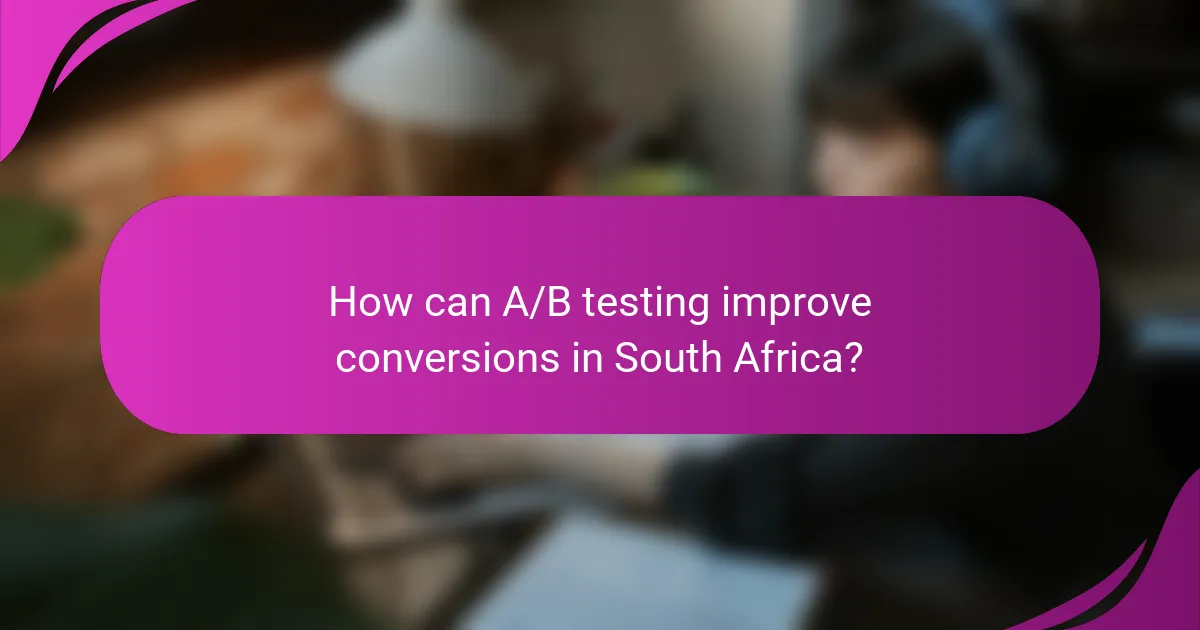A/B testing is a powerful tool for businesses looking to enhance conversions by comparing different versions of web pages or marketing materials. By identifying which variations resonate more with specific audiences, companies can drive increased sales and engagement. Key elements of A/B testing include control and variation groups, hypothesis formulation, and success metrics, all crucial for effective testing. Employing targeted strategies such as segmented audience testing and multivariate testing can further optimize results and support data-driven decision-making.

How can A/B testing improve conversions in South Africa?
A/B testing can significantly enhance conversions in South Africa by allowing businesses to compare different versions of their web pages or marketing materials. This method helps identify which variations resonate better with local audiences, ultimately leading to increased sales and engagement.
Increased user engagement
By using A/B testing, businesses can tailor their content to better meet the preferences of South African users. For instance, testing different headlines or images can reveal what captures attention more effectively, leading to longer time spent on the site.
Engagement metrics, such as time on page and interaction rates, can improve when users find content that speaks directly to their interests. This can be particularly impactful in a diverse market like South Africa, where cultural nuances play a significant role in user preferences.
Higher click-through rates
A/B testing can lead to higher click-through rates (CTR) by optimizing call-to-action buttons and links. For example, testing different colors, placements, or wording can show which variations encourage more users to click.
In South Africa, where mobile usage is prevalent, ensuring that CTAs are mobile-friendly can further enhance CTR. Simple adjustments, like making buttons larger or more visually appealing, can yield significant improvements in user action.
Optimized landing pages
Creating optimized landing pages through A/B testing can directly impact conversion rates. By experimenting with different layouts, content, and offers, businesses can determine which combinations lead to the highest conversion rates.
For South African businesses, incorporating local language and cultural references can make landing pages more relatable. Testing various headlines and images can help identify what resonates best with the target audience, leading to improved performance.
Data-driven decision making
A/B testing fosters data-driven decision making by providing concrete evidence of what works and what doesn’t. This approach allows businesses to make informed choices based on user behavior rather than assumptions.
In South Africa, where market dynamics can change rapidly, relying on data from A/B tests can help businesses stay agile and responsive. Regularly analyzing test results can guide future marketing strategies and enhance overall effectiveness.

What are the key elements of A/B testing?
A/B testing involves comparing two versions of a webpage or app to determine which performs better in achieving a specific goal. The key elements include the control group, variation group, hypothesis formulation, and success metrics, all of which are essential for effective testing and conversion improvement.
Control group
The control group is the original version of the webpage or app that users interact with during the A/B test. This group serves as a baseline to measure the performance of the variation group against. It’s crucial to ensure that the control group remains unchanged throughout the testing period to obtain accurate results.
When setting up the control group, consider factors such as traffic distribution and user demographics to ensure a fair comparison. Typically, around 50% of the traffic should be directed to the control group for balanced results.
Variation group
The variation group is the modified version of the webpage or app that incorporates changes intended to improve performance. These changes can include different headlines, images, layouts, or calls to action. The goal is to identify which specific elements lead to better user engagement or conversion rates.
It’s essential to limit the number of changes made in the variation group to isolate the impact of each element. Testing one change at a time can provide clearer insights into what drives performance improvements.
Hypothesis formulation
Hypothesis formulation is the process of creating a clear statement predicting the outcome of the A/B test. A well-defined hypothesis should be specific, measurable, and based on prior data or user feedback. For example, “Changing the call-to-action button color from blue to green will increase click-through rates by 15%.”
Formulating a strong hypothesis helps guide the testing process and provides a framework for analyzing results. Ensure that your hypothesis is aligned with your overall business goals for maximum relevance.
Success metrics
Success metrics are the key performance indicators (KPIs) used to evaluate the effectiveness of the A/B test. Common metrics include conversion rates, click-through rates, and user engagement levels. Selecting the right metrics is critical to understanding the impact of the changes made in the variation group.
When defining success metrics, consider both quantitative and qualitative data. For instance, while conversion rates provide hard numbers, user feedback can offer insights into the reasons behind those numbers. Aim for a statistically significant sample size to ensure the reliability of your results.

What strategies enhance A/B testing effectiveness?
Effective A/B testing strategies focus on targeted approaches that increase the reliability and relevance of results. By implementing techniques such as segmented audience testing, multivariate testing, and optimizing testing frequency, businesses can significantly improve conversion rates and make data-driven decisions.
Segmented audience testing
Segmented audience testing involves dividing your audience into distinct groups based on demographics, behavior, or preferences. This allows for more tailored experiments that can yield insights specific to each segment, enhancing the overall effectiveness of A/B tests.
For example, a retailer might test different website layouts for new customers versus returning customers. By analyzing the results separately, the retailer can identify which design resonates better with each group, leading to higher conversion rates.
Multivariate testing
Multivariate testing examines multiple variables simultaneously to determine which combination yields the best results. Unlike traditional A/B testing, which focuses on one element at a time, multivariate testing can provide a more comprehensive understanding of how different elements interact.
For instance, a company might test various headlines, images, and call-to-action buttons all at once. This approach can be more complex but often reveals deeper insights into user preferences and behaviors, ultimately guiding more effective design choices.
Testing frequency optimization
Optimizing testing frequency is crucial to ensuring that results are both timely and relevant. Conducting tests too infrequently can lead to outdated insights, while testing too often may yield inconclusive results due to insufficient data.
A good rule of thumb is to run tests until you achieve statistical significance, which typically requires a sample size that reflects your audience. Depending on traffic levels, this could mean running tests for several days to weeks, ensuring that you gather enough data to make informed decisions.

What tools are available for A/B testing?
Several tools are available for A/B testing, each offering unique features and capabilities to help optimize conversion rates. The right choice depends on your specific needs, budget, and technical expertise.
Optimizely
Optimizely is a leading A/B testing platform known for its user-friendly interface and robust functionality. It allows users to create experiments without extensive coding knowledge, making it accessible for marketers and product teams alike.
Key features include multivariate testing, personalization options, and detailed analytics. Optimizely is particularly effective for larger organizations that require advanced testing capabilities and integration with other marketing tools.
Google Optimize
Google Optimize is a free tool that integrates seamlessly with Google Analytics, making it a popular choice for businesses looking to start A/B testing without significant investment. It offers a straightforward setup for experiments and provides insights based on existing Google Analytics data.
While it may lack some advanced features found in paid tools, Google Optimize is suitable for small to medium-sized businesses aiming to improve their website performance through simple A/B tests.
VWO
VWO (Visual Website Optimizer) is another comprehensive A/B testing tool that focuses on enhancing user experience and conversion rates. It provides a visual editor for creating tests, allowing users to modify elements on their site easily.
VWO also includes features like heatmaps, session recordings, and detailed reporting, which help in understanding user behavior. This tool is ideal for businesses that want a holistic view of their website’s performance and user interactions.

How to analyze A/B testing results?
Analyzing A/B testing results involves evaluating the performance of different variations to determine which one yields better outcomes. Key metrics such as statistical significance, conversion rates, and behavioral insights provide a comprehensive view of the test results.
Statistical significance
Statistical significance helps determine whether the results observed in an A/B test are likely due to the variations tested rather than random chance. A common threshold for significance is a p-value of less than 0.05, indicating that there is less than a 5% probability that the observed differences occurred by chance.
To assess statistical significance, use tools like t-tests or chi-squared tests, depending on your data type. Ensure your sample size is adequate; larger samples generally yield more reliable results, reducing the margin of error.
Conversion rate comparison
Conversion rate comparison involves measuring the percentage of users who complete a desired action in each variation. For example, if Variation A has a conversion rate of 10% and Variation B has 15%, B is performing better.
When comparing conversion rates, consider the context of your industry. A conversion rate of 2-5% may be typical for e-commerce, while SaaS platforms might aim for higher rates. Always analyze the data in relation to your specific goals and benchmarks.
Behavioral insights
Behavioral insights provide qualitative data on how users interact with each variation. Tools such as heatmaps and session recordings can reveal user preferences and pain points, helping to explain why one variation outperforms another.
Look for patterns in user behavior, such as drop-off points or areas of high engagement. This information can guide future design and content decisions, ensuring that your A/B testing strategy evolves based on real user feedback.

What are common A/B testing pitfalls?
Common A/B testing pitfalls include inadequate sample sizes, testing too many variables at once, and failing to consider external factors. These mistakes can lead to misleading results and ineffective strategies, ultimately hindering conversion improvement efforts.
Insufficient sample size
Using an insufficient sample size can skew A/B testing results, making it difficult to draw accurate conclusions. A small sample may not represent the broader audience, leading to unreliable data. Aim for a sample size that reflects your typical visitor numbers to ensure more robust findings.
Testing multiple variables simultaneously
Testing multiple variables at once can complicate the analysis and obscure which change drove the results. Focus on one variable at a time to isolate its impact effectively. For example, if you change both the headline and the call-to-action button color, you won’t know which change influenced user behavior.
Ignoring external factors
External factors, such as seasonality or marketing campaigns, can significantly affect A/B test outcomes. Failing to account for these variables may lead to incorrect interpretations of the data. Always consider the context in which the test is conducted and aim to run tests during similar conditions for more reliable comparisons.
Not defining success metrics
Without clear success metrics, it is challenging to determine the effectiveness of your A/B tests. Define specific goals, such as conversion rates or click-through rates, before starting the test. This clarity will help you assess the results accurately and make informed decisions based on the data.
Stopping tests too early
Ending A/B tests prematurely can result in inconclusive data and missed opportunities for optimization. Allow tests to run for a sufficient duration to gather enough data for statistical significance. A common rule of thumb is to run tests for at least one to two business cycles to capture variations in user behavior.

